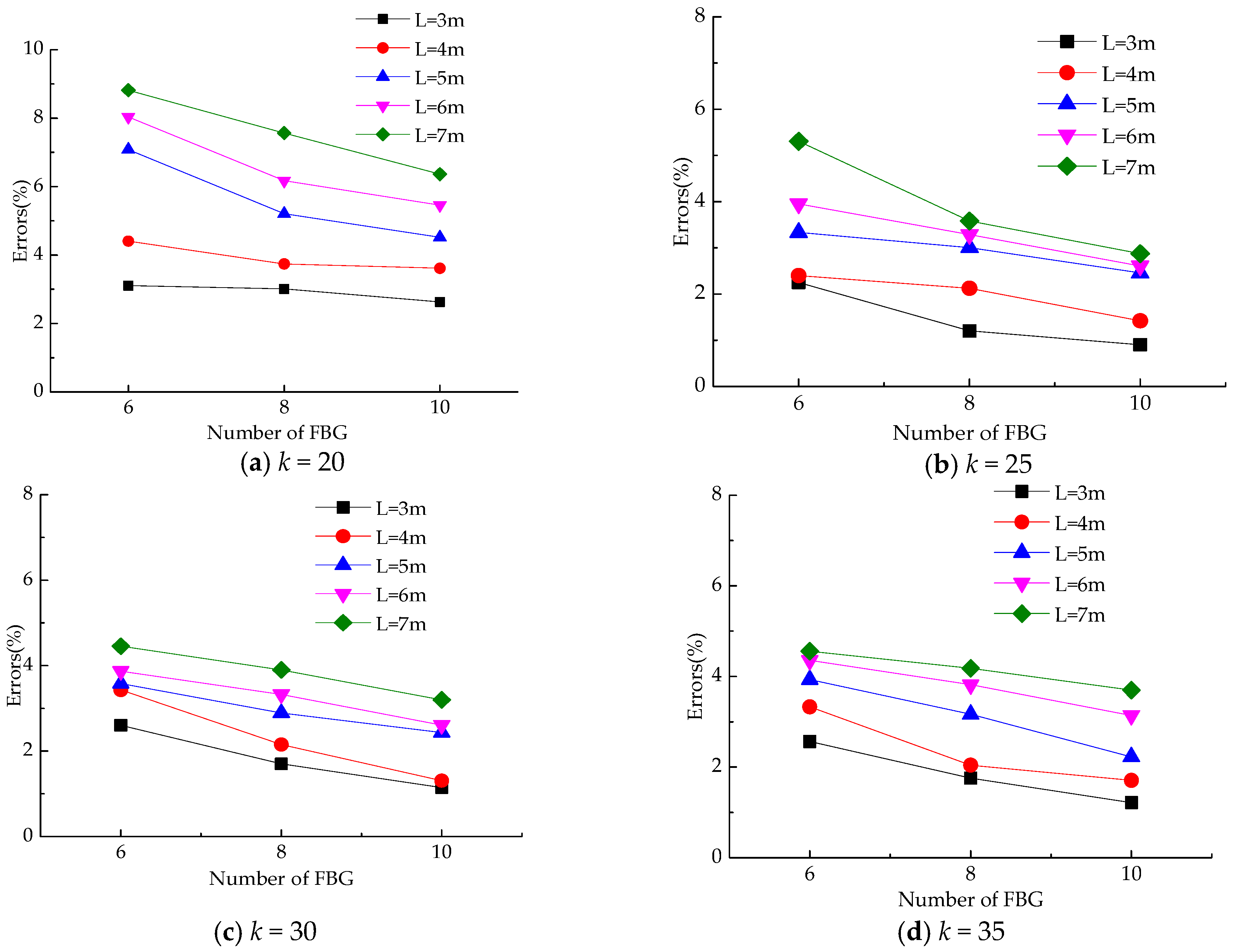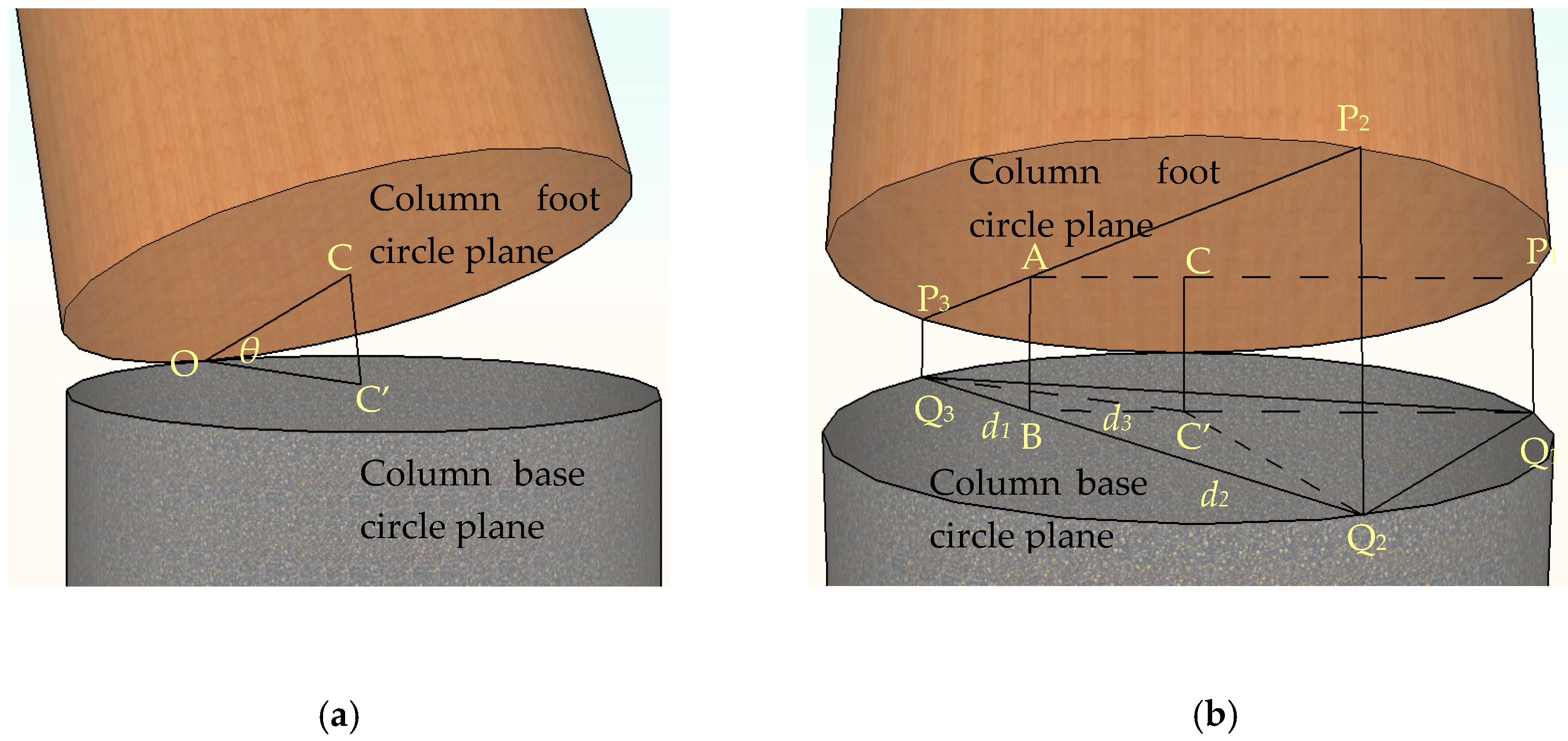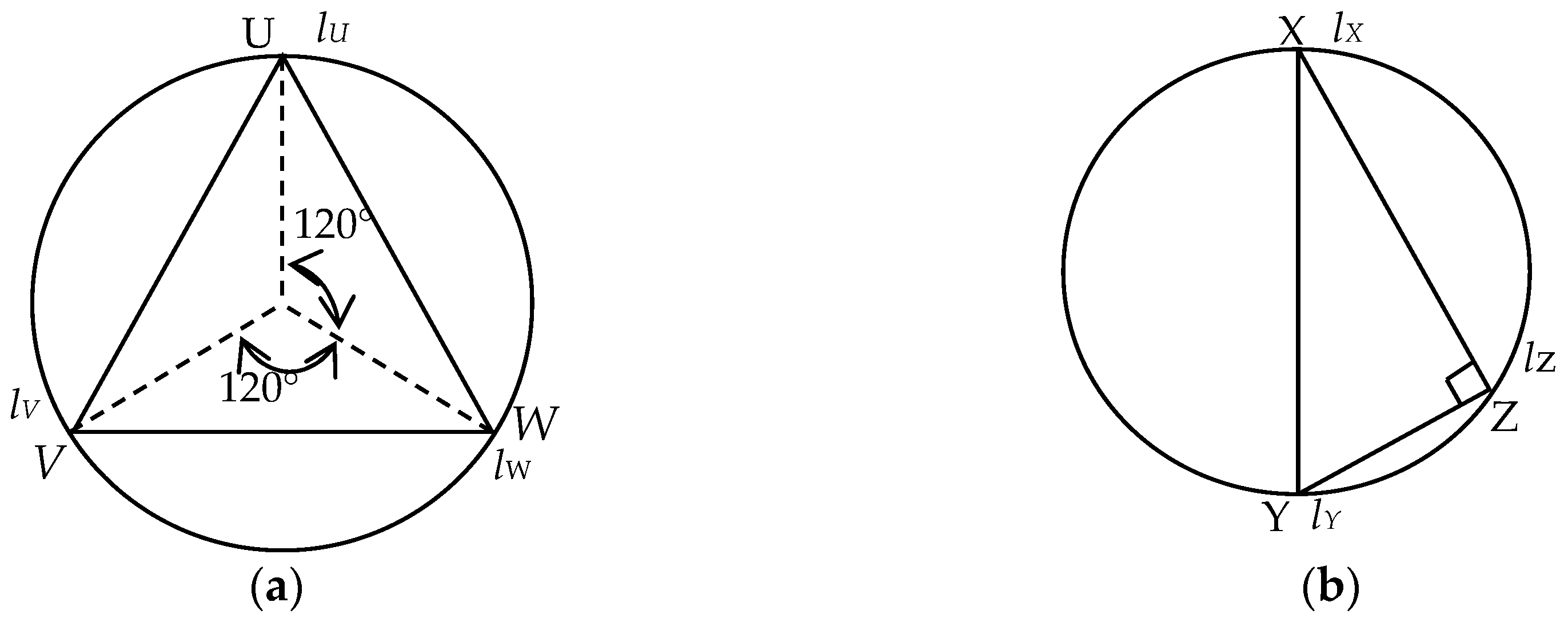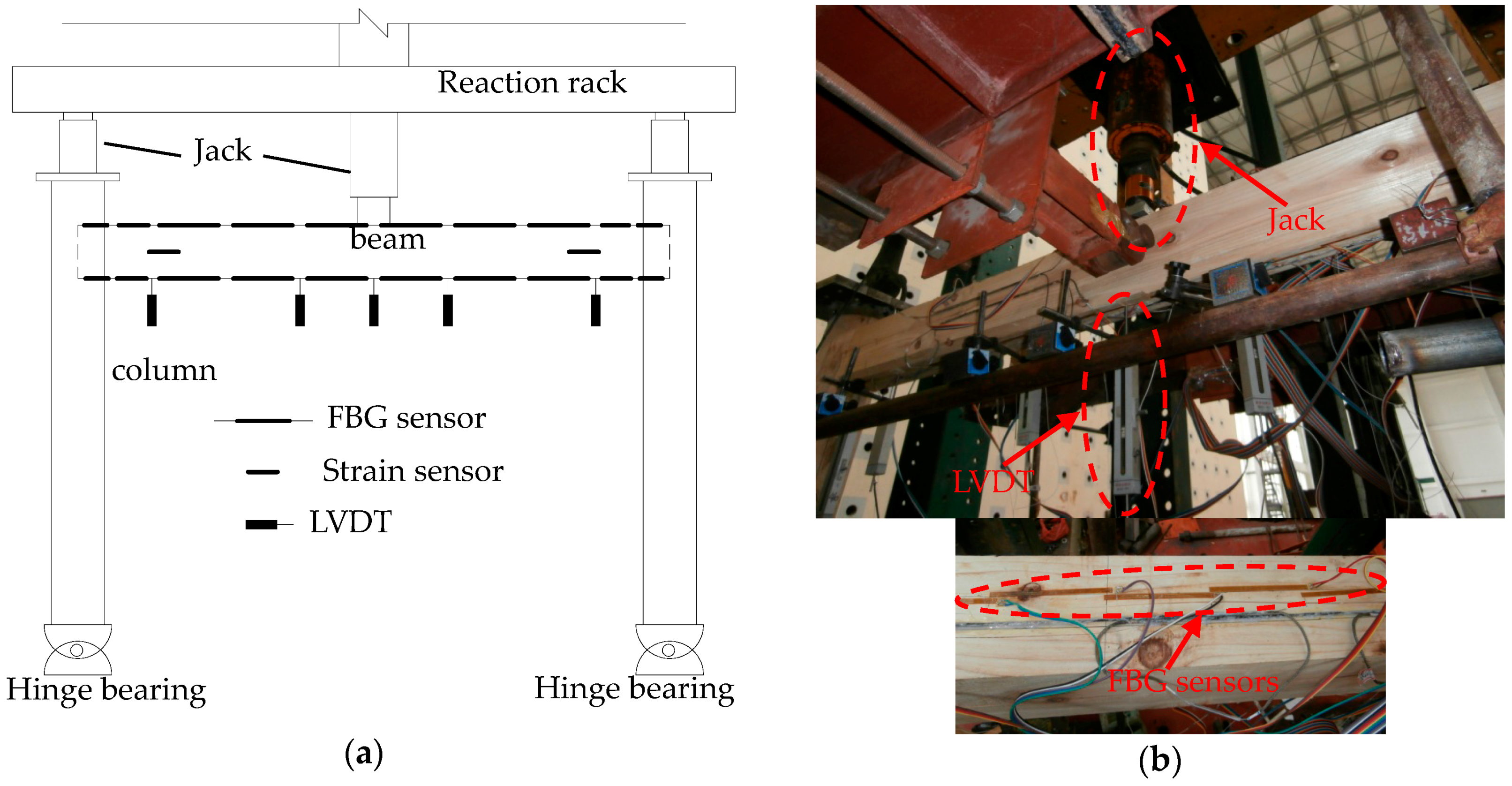Deformation Monitoring for Chinese Traditional Timber Buildings Using Fiber Bragg Grating Sensors
Abstract
:1. Introduction
2. Deformation Monitoring Methods Based on FBG Sensors
2.1. Deflection Monitoring of Chinese Traditional Timber Beams
- Semi-rigid joint support
- Support settlement
- Irregular section
2.1.1. Strain-based Deflection Equation Derivation for Simply-Supported Beam
2.1.2. The Influence Factor Analysis
Semi-Rigid Tenon Joint Support
Support Settlement
Irregular Section
2.1.3. Feasibility of the Timber Deflection Equation
2.2. Tilt Monitoring of Chinese Traditional Timber Column
2.2.1. FBG-Based Tilting Monitoring Method of Timber Column
2.2.2. Applicability of Timber Column Monitoring Methods
Deployment of Sensors
Applicable Range
2.3. Dislocation Monitoring of Mortise-Tenon Joints
3. Experimental Validation
3.1. Deflection Monitoring of Timber Beam
3.1.1. Test Setup and Sensors Placement
3.1.2. Timber Beam Test Data and Analysis
3.2. Tilting Deformation Monitoring of Timber Column
3.2.1. Test Setup and Sensors Placement
3.2.2. Tilt Test Process and Results Analysis
Calculation and Analysis of Column Inclination
Verification of Rigid Rotation for the Column
3.3. Test Verification: Dislocation Monitoring of Mortise-tenon Joint
Test Setup and Layout of Sensors
4. Conclusions
- (1)
- This paper proposes a timber beam deflection monitoring method that takes account of semi-rigid joint support, support settlement and irregular section, which is applicable and proved effective for Chinese traditional timber beams through experimental validation. The precision of the algorithm is dependent on the beam’s span-to-height ratio and the number of the sensors.
- (2)
- The FBG-based timber column tilt monitoring technology is applicable and effective by comparing the timber column tilt amount from the LVDTs and the method proposed in this paper. Besides, it can be drawn that the column rotates rigidly when it tilts through comparing the column strain measured by the strain gauge and the amount of column tilt.
- (3)
- The dislocation monitoring method is proposed to monitor the mortise-tenon joints for Chinese traditional buildings. The applicability and effectiveness are indirectly validated by experimental results.
Author Contributions
Acknowledgments
Conflicts of Interest
References
- Kan, Y.; Zhao, H.T.; Xue, J.Y.; Sui, Y. Monolithic stability analysis of timber frame in historical buildings. World Earthqu. Eng. 2008, 24, 73–76. (In Chinese) [Google Scholar]
- Lorenzoni, F.; Casarin, F.; Modena, C.; Mauro, C.; Kleidi, I.; Francesca, P. Structural health monitoring of the Roman Arena of Verona. J. Civ. Struct. Health Monit. 2013, 3, 227–246. [Google Scholar] [CrossRef]
- Min, K.W.; Kim, J.; Park, S.A.; Park, C. Ambient vibration testing for story stiffness estimation of a heritage timber building. Sci. World J. 2013, 206–232. [Google Scholar] [CrossRef] [PubMed]
- Wu, M.H. Study on Monitoring Technique and Damage Evolution Method of Ancient Timber Structure Considering the Long-Term Environment Effect and Seismic Effect. Ph.D. Thesis, Fuzhou University, Fuzhou, China, 2017. [Google Scholar]
- Fang, D.P.; Iwasaki, S.; Yu, M.H.; Shen, Q.P.; Miyamoto, Y.; Hikosaka, H. Ancient Chinese timber architecture. II: dynamic characteristics. J. Struct. Eng. 2017, 127, 1358–1364. [Google Scholar] [CrossRef]
- Hanhifirvi, A. Computational method for predicting the long-term performance of timber beams in variable climates. Mater. Struct. 2000, 33, 127–134. [Google Scholar] [CrossRef]
- Risia, A.D.; Focacci, F.; Luciano, R. Experimental investigation on flexural behavior of timber beams repaired with CFRP plates. Compos. Struct. 2014, 108, 720–728. [Google Scholar]
- Liang, T.; Wang, Y.W.; Ni, T.Z. GB/50165-1992. In Technical Specification for Maintenance and Reinforcement of Ancient Buildings; China Standard Press: Beijing, China, 1992; pp. 154–196. [Google Scholar]
- Luo, M.; Li, W.; Wang, J.; Wang, N.; Chen, X.; Song, G. Development of a novel guided wave generation system using a giant magnetostrictive actuator for nondestructive evaluation. Sensors 2018, 18, 779. [Google Scholar] [CrossRef] [PubMed]
- Lu, G.; Feng, Q.; Li, Y.; Wang, H.; Song, G. Characterization of ultrasound energy diffusion due to small-size damage on an aluminum plate using piezoceramic transducers. Sensors 2017, 17, 2796. [Google Scholar] [CrossRef] [PubMed]
- Ho, S.C.M.; Li, W.; Razavi, M.; Song, G. Fiber bragg grating based arterial localization device. Smart Mater. Struct. 2017, 26, 065020. [Google Scholar] [CrossRef]
- Qi, B.; Kong, Q.; Qian, H.; Patil, D.; Lim, I.; Li, M.; Liu, D.; Song, G. Study of impact damage in PVA-ECC beam under low-velocity impact loading using piezoceramic transducers and PVDF thin-film transducers. Sensors 2018, 18, 671. [Google Scholar] [CrossRef] [PubMed]
- Dumoulin, C.; Deraemaeker, A. Real-time fast ultrasonic monitoring of concrete cracking using embedded piezoelectric transducers. Smart Mater. Struct. 2017, 26, 104006. [Google Scholar] [CrossRef] [Green Version]
- Song, G.; Li, W.; Wang, B.; Ho, S.C.M. A review of rock bolt monitoring using smart sensors. Sensors 2017, 17, 776. [Google Scholar] [CrossRef] [PubMed]
- Todd, M.; Yeager, M.; Key, C.; Gregory, W. Assessment of embedded Fiber Bragg Gratings for structural health monitoring of composites. Struct. Health Monit. 2017, 16, 262–275. [Google Scholar] [CrossRef]
- Li, W.; Xu, C.; Ho, S.C.M.; Wang, B.; Song, G. Monitoring concrete deterioration due to reinforcement corrosion by integrating acoustic emission and FBG strain measurements. Sensors 2017, 17, 657. [Google Scholar] [CrossRef] [PubMed]
- Mao, J.; Xu, F.; Qian, G.; Liu, S.; Jin, W.; Xu, Y. A monitoring method based on FBG for concrete corrosion cracking. Sensors 2016, 16, 1093. [Google Scholar] [CrossRef] [PubMed]
- Jiang, S.F.; Tang, W.J.; Wu, M.H. Deformation monitoring method of ancient wooden beam based on FBG strain measurement. Earthqu. Eng. Eng. Vibr. 2016, 36, 198–206. [Google Scholar]
- Feio, A.; Machado, J.S. In-situ assessment of timber structural members: Combining information from visual strength grading and NDT/SDT methods—A review. Constr. Build. Mater. 2015, 101, 1157–1165. [Google Scholar] [CrossRef]
- Li, H.N.; Li, D.S.; Song, G.B. Recent applications of fiber optic sensors to health monitoring in civil engineering. Eng. Struct. 2004, 26, 1647–1657. [Google Scholar] [CrossRef]
- Marsili, R.; Rossi, G.; Speranzini, E. Fibre Bragg Gratings for the monitoring of wooden structures. Materials 2018, 11, 7. [Google Scholar] [CrossRef] [PubMed]
- Wang, J.; Yang, N.; Yang, Q.S. Structural health monitoring system for heritage buildings. J. Beijing Jiaotong Univ. 2015, 34, 100–104. [Google Scholar]
- Shen, S.; Wu, Z.S.; Yang, C.Q. Research on Monitoring Deformation Distribution of Structure by Improved Conjugate Beam Method Based on Distributed Optical Fiber Strain Sensing Technology. China Civ. Eng. J. 2010, 43, 63–70. (In Chinese) [Google Scholar]
- Sun, X.F.; Fang, X.S.; Guan, L.T.; Hu, Z.Q.; Guo, L.; Jiang, X.Y. Material Mechanics I, 5th ed.; Higher Education Press: Beijing, China, 2012; pp. 158–159. [Google Scholar]
- Li, J. Chinese Ancient Building Method; Commercial Press: Hong Kong, China, 1933; pp. 79–82. ISBN 9787560971087. [Google Scholar]
- Wang, T. Research on the Static Performance of Chinese Ancient Wood Frames; Heritage Press: Beijing, China, 1992; pp. 63–81. [Google Scholar]
- Wu, M.H.; Tang, W.J.; Jiang, S.F. Deformation Monitoring Strategy of Ancient Built Wood Structure Based on Distributed Optical Fiber Technology. J. Fuzhou Univ. 2018. (In Chinese) [Google Scholar]
- Zhao, H.T.; Zhang, X.C.; Xue, J.Y. Conceptual design thoughts of Chinese ancient timber buildings. J. Xi’an Univ. Archit. Technol. 2011, 43, 457–463. (In Chinese) [Google Scholar]
- Li, S.Z.; Wu, Z.S. Development of Distributed Long-gauge Fiber Optic Sensing System for Structural Health Monitoring. Struct. Health Monit. 2007, 6, 133–143. [Google Scholar] [CrossRef]
- Ren, L. Application of Fiber Grating Sensing Technology in Structural Health Monitoring. Ph.D. Thesis, Dalian University of Technology, Dalian, China, 2008. [Google Scholar]
- YHD-Displacement Sensor YDH DC Displacement Sensor. Available online: https://wenku.baidu.com/view/aff51c3a83c4bb4cf7ecd160.html (accessed on 5 June 2018).

















| Span-To-Height Ratio k | k ≥ 30 | 25 ≤ k < 30 | 20 ≤ k < 25 | |
|---|---|---|---|---|
| Length of span | <5 m | 6 | 8 | 8 |
| ≥5 m | 6 | 8 | 10 | |
| Gauge Length l | 100 | 200 | 300 | 400 | 500 | 600 | 700 | 800 | 1,000 |
|---|---|---|---|---|---|---|---|---|---|
| Radius r | 42 | 84 | 125 | 167 | 201 | 251 | 292 | 334 | 418 |
| Load Level F/kN | 4 | 6 | 8 | 10 | 12 | 14 | 16 |
|---|---|---|---|---|---|---|---|
| Δl/mm | −0.06 | −0.1 | −0.12 | −0.16 | −0.22 | −0.28 | −0.32 |
| Δr/mm | −0.02 | −0.06 | −0.1 | −0.14 | −0.2 | −0.26 | −0.28 |
| d 1 /mm | Strain Difference under Different Loads/με | ||||||
|---|---|---|---|---|---|---|---|
| 4 kN | 6 kN | 8 kN | 10 kN | 12 kN | 14 kN | 16 kN | |
| 150 | 190 | 300 | 367 | 421 | 457 | 503 | 538 |
| 450 | 440 | 579 | 714 | 846 | 993 | 1067 | 1137 |
| 750 | 676 | 941 | 1242 | 1510 | 1707 | 1900 | 2058 |
| 1050 | 849 | 1222 | 1633 | 2015 | 2361 | 2590 | 2797 |
| 1350 | 929 | 1137 | 1883 | 2118 | 2404 | 2599 | 2833 |
| 1650 | 607 | 877 | 1169 | 1454 | 1749 | 2034 | 2319 |
| 1950 | 438 | 599 | 783 | 953 | 1120 | 1266 | 1406 |
| 2250 | 190 | 291 | 361 | 420 | 480 | 545 | 587 |
| No. of Sensors | Strain under Different Loading Stages/uε | |||||||||||
|---|---|---|---|---|---|---|---|---|---|---|---|---|
| 1 | 2 | 3 | 4 | 5 | 6 | 7 | 8 | 9 | 10 | 11 | 12 | |
| 1 | 531 | 964 | 1654 | 1995 | 2432 | 2927 | 3560 | 4023 | 4461 | 4852 | 5852 | 6261 |
| 2 | 346 | 531 | 730 | 830 | 919 | 1008 | 1117 | 1174 | 1231 | 1259 | 1330 | 1335 |
| 3 | 217 | 303 | 322 | 341 | 322 | 227 | 4 | 127 | 276 | 426 | 783 | 896 |
| No. of Sensors | Strain under Different Loading Stages/uε | |||||||||||
|---|---|---|---|---|---|---|---|---|---|---|---|---|
| 13 | 14 | 15 | 16 | 17 | 18 | 19 | 20 | 21 | 22 | 23 | 24 | |
| 1 | 5754 | 5111 | 4532 | 4033 | 3383 | 2797 | 2208 | 1628 | 1328 | 924 | 268 | 124 |
| 2 | 1339 | 1319 | 1320 | 1286 | 1188 | 1080 | 938 | 805 | 710 | 545 | 201 | 109 |
| 3 | 762 | 591 | 432 | 325 | 100 | 123 | 297 | 311 | 264 | 320 | 126 | 43 |
| Loading Amplitude | 20 1 | −20 2 | 40 | −40 | 60 | −60 | 80 | −80 |
|---|---|---|---|---|---|---|---|---|
| Left column | −0.066 | 0.044 | −1.749 | 1.379 | −1.991 | 2.45 | −2.255 | 3.043 |
| Right column | −0.165 | −0.385 | −0.55 | −1.309 | 1.705 | −2.046 | 0.583 | −4.07 |
| Loading Amplitude | 100 | −100 | 120 | −120 | 140 | −140 | 160 | −160 |
| Left column | −5.175 | 3.7125 | −7.5 | 4.4875 | −8.575 | 6.096 | −8.062 | 8.695 |
| Right column | 4.68 | −2.9 | 5.985 | −4.05 | 7.2325 | −6.412 | 9.390 | −7.5 |
© 2018 by the authors. Licensee MDPI, Basel, Switzerland. This article is an open access article distributed under the terms and conditions of the Creative Commons Attribution (CC BY) license (http://creativecommons.org/licenses/by/4.0/).
Share and Cite
Li, N.-L.; Jiang, S.-F.; Wu, M.-H.; Shen, S.; Zhang, Y. Deformation Monitoring for Chinese Traditional Timber Buildings Using Fiber Bragg Grating Sensors. Sensors 2018, 18, 1968. https://doi.org/10.3390/s18061968
Li N-L, Jiang S-F, Wu M-H, Shen S, Zhang Y. Deformation Monitoring for Chinese Traditional Timber Buildings Using Fiber Bragg Grating Sensors. Sensors. 2018; 18(6):1968. https://doi.org/10.3390/s18061968
Chicago/Turabian StyleLi, Ni-Lei, Shao-Fei Jiang, Ming-Hao Wu, Sheng Shen, and Ying Zhang. 2018. "Deformation Monitoring for Chinese Traditional Timber Buildings Using Fiber Bragg Grating Sensors" Sensors 18, no. 6: 1968. https://doi.org/10.3390/s18061968





